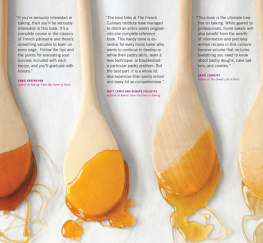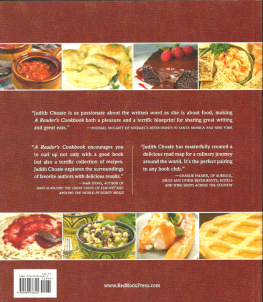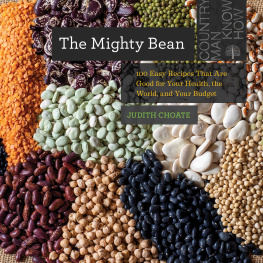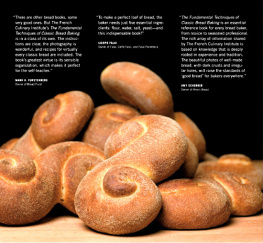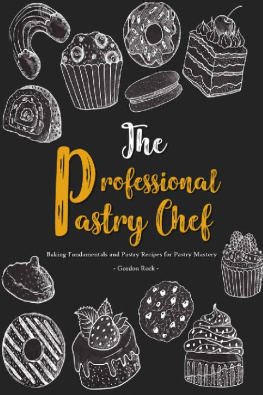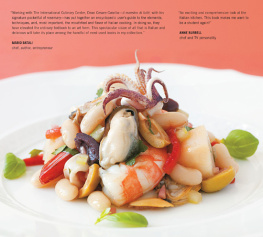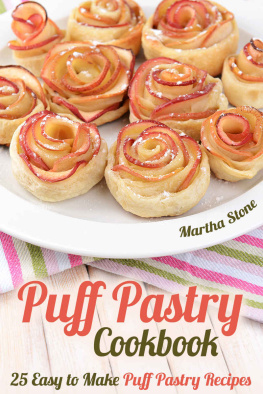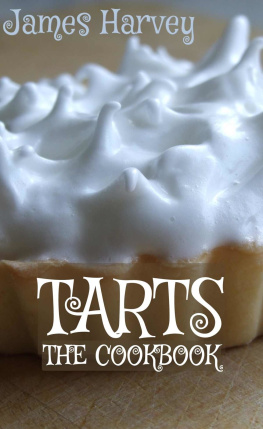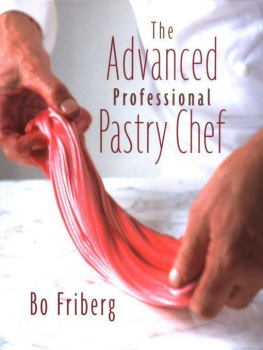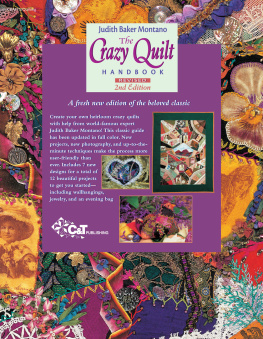Judith Choate - The Fundamental Techniques of Classic Pastry Arts
Here you can read online Judith Choate - The Fundamental Techniques of Classic Pastry Arts full text of the book (entire story) in english for free. Download pdf and epub, get meaning, cover and reviews about this ebook. year: 2009, publisher: Abrams, genre: Children. Description of the work, (preface) as well as reviews are available. Best literature library LitArk.com created for fans of good reading and offers a wide selection of genres:
Romance novel
Science fiction
Adventure
Detective
Science
History
Home and family
Prose
Art
Politics
Computer
Non-fiction
Religion
Business
Children
Humor
Choose a favorite category and find really read worthwhile books. Enjoy immersion in the world of imagination, feel the emotions of the characters or learn something new for yourself, make an fascinating discovery.
- Book:The Fundamental Techniques of Classic Pastry Arts
- Author:
- Publisher:Abrams
- Genre:
- Year:2009
- Rating:5 / 5
- Favourites:Add to favourites
- Your mark:
- 100
- 1
- 2
- 3
- 4
- 5
The Fundamental Techniques of Classic Pastry Arts: summary, description and annotation
We offer to read an annotation, description, summary or preface (depends on what the author of the book "The Fundamental Techniques of Classic Pastry Arts" wrote himself). If you haven't found the necessary information about the book — write in the comments, we will try to find it.
The Fundamental Techniques of Classic Pastry Arts — read online for free the complete book (whole text) full work
Below is the text of the book, divided by pages. System saving the place of the last page read, allows you to conveniently read the book "The Fundamental Techniques of Classic Pastry Arts" online for free, without having to search again every time where you left off. Put a bookmark, and you can go to the page where you finished reading at any time.
Font size:
Interval:
Bookmark:

Published in 2009 by Stewart, Tabori & Chang
An imprint of ABRAMS
Text copyright 2009 by The French Culinary Institute
Photographs copyright 2009 by Matthew Septimus
All rights reserved. No portion of this book may be reproduced, stored in a retrieval system, or transmitted in any form or by any means, mechanical, electronic, photocopying, recording, or otherwise, without written permission from the publisher.
Library of Congress Cataloging-in-Publication Data:
Choate, Judith.
The fundamental techniques of classic pastry arts / The French Culinary Institute with Judith Choate. p. cm.
Includes bibliographical references.
ISBN 978-1-58479-803-3
eISBN 978-1-61312-271-6
1. Pastry. 2. Cookery, French. I. French Culinary Institute (New York, N.Y.) II. Title.
TX773 .C5258
641.865dc22
2009006902
Editor: Luisa Weiss
Designer: Debra Drodvillo/Notion Studio
Photo Art Director: Julie Hoffer
Production Manager: Tina Cameron

ABRAMS The Art of Books
195 Broadway, New York, NY 10007
abramsbooks.com
THE FRENCH CULINARY INSTITUTE
Judith Choate with
The Pastry Chefs of The French Culinary Institute
Photographs by Matthew Septimus
Stewart, Tabori & Chang New York

Contents
Foreword
Pastry chefs are a breed unto themselves, different from culinary chefs or bread bakers. How? Well, think about it. Pastry covers many disciplines: cake baking, dough working, candy making, chocolate tempering, complex cake construction, and sugar pulling, just to name a few. All these tasks take incredible precision. Once you mix a cake and place it in the oven, there is no chance of adding a little more sugar while it is baking. Thus, a great pastry chef must have a fastidious nature. At The International Culinary Center and The French Culinary Institute, we find that there are many career changers drawn to our pastry course from other precise fields... for example, medical personnel, accountants, architects, and a startling number of dentists!
Walk into a pastry kitchen, and it is much quieter than a culinary kitchen. You can see the concentration and intensity on the faces of the cooks. The utensils they use are exacting: thermometers, scales, and sculpting knives. Missing is the cacophony of clanging pots hitting the stovetop or the shouting of orders or the visual excitement of a flare-up of flames on a grill.
As fun as it might sound to spend your days working with chocolate and sugar, studying to become a ptissier should not be likened to an adult version of the game of Candyland. The profession demands that the pastry chef be disciplined and intelligent, have physical stamina, understand proportions, and possess artistic sensibility. Perhaps above all, technique is the most important of the fundamentals. That is the driver of The FCI course, and in this text, we share with you all the basic techniques that an aspiring pastry chef must master. The courses architect was none other than Jacques Torres. Chef Torres, known to many as Mr. Chocolate, is one of the few anointed master chefs of pastry alive today. In France a master ptissier is chosen after a grueling competition. The title won is M.O.F. (Meilleur Oeuvrier de Franceliterally, Master Craftsman of France). Chef Torres, at the time he won the title, was only twenty-sixthe youngest ever to have achieved this vaunted honor. In addition to winning all types of awards and being the pastry chef of the acclaimed restaurant Le Cirque in New York City, Chef Torres brought a humility to writing our course. He did not want only to reflect his unique style, so he consulted all the top pastry chefs in the city. That approach bestowed on The FCI a course that is relevant, thorough, and exciting. The recipes are reflective of what is being produced in the top pastry kitchens todayand include the classic dishes that are fundamental, timeless, and demand the knowledge of professional techniques.
The true wealth of this book is that it distills ten years of trial and error in teaching students. We have a seasoned and brilliant pastry faculty at The FCI who have taught and refined this curriculum over the years. Their consolidated wisdom is captured in these pages. Work through this book and you will not only acquire the fundamental professional techniques, but you will also have the benefit of hundreds of years of professional expertise.
Let me close by inviting you to visit us at The French Culinary Institute in New York City and see this curriculum in action, not to mention marvel at some of the most delicious cakes and sweets known to humankind!
Dorothy Cann Hamilton

Introduction
My approach is to perfect a strong foundation of pastry and baking basics. Once these are mastered, there is no limit as to what you can create.
Chef Jacques Torres
When Dorothy Hamilton asked me to lead the pastry course at The French Culinary Institute, I was amazed to learn that I would have no budget constraints as I built the pastry kitchens and staff. For my entire professional life, the driving force in the kitchen was, for the most part, economics; I was taught to make the best of what was available to me. But at FCI, my only requirement was to built the best kitchens and staff possible, so that we might give students the maximum opportunity to learn. What a pleasure that was, and what a pleasure it has been to participate in the training of new generations of creative pastry chefs.
In the few years since I began my career in the United States, the profession of pastry chef has changed and grown dramatically. No longer is there the time for a young cook to go from job to job, learning the specialty of the house at each stop. Because of exploding demand, obtaining skills and techniques must be accelerated in an educational setting like The French Culinary Institute, where doors are opened for a successful future in the pastry kitchen. I like to say that we teach a young chef to use the head, while experience teaches how to use the hands.
Pastry work is extremely demanding, both mentally and physically. While we can teach the techniques of the craft, there are several attributes that a cook must possess in order to succeed.
1. Because so much of our work is repetitive, the number-one requirement is discipline. Repetition in the pastry kitchen creates the result; a task can be mastered only by being practiced over and over again. Musicians have an adage that translates well to pastry chefs: Amateurs play a piece until they get it right, while professionals play it until they cant get it wrong. Discipline gives the pastry chef the willingness to practice until it is impossible to fail.
2. Dedication to the craft builds a sense of structure and responsibility for all aspects of the pastry kitchen. This concern extends not just to the end product, but to fellow workers and customers as well.
3. Desire for knowledge about the art of pastry making will ensure that learning never stops. After more than twenty-five years as a pastry chef, I am still excited to discover anything new that applies to my work. An untried ingredient, a unique skill, state-of the-art equipment, advanced technologyall these contribute to improving my craft.
Next pageFont size:
Interval:
Bookmark:
Similar books «The Fundamental Techniques of Classic Pastry Arts»
Look at similar books to The Fundamental Techniques of Classic Pastry Arts. We have selected literature similar in name and meaning in the hope of providing readers with more options to find new, interesting, not yet read works.
Discussion, reviews of the book The Fundamental Techniques of Classic Pastry Arts and just readers' own opinions. Leave your comments, write what you think about the work, its meaning or the main characters. Specify what exactly you liked and what you didn't like, and why you think so.

